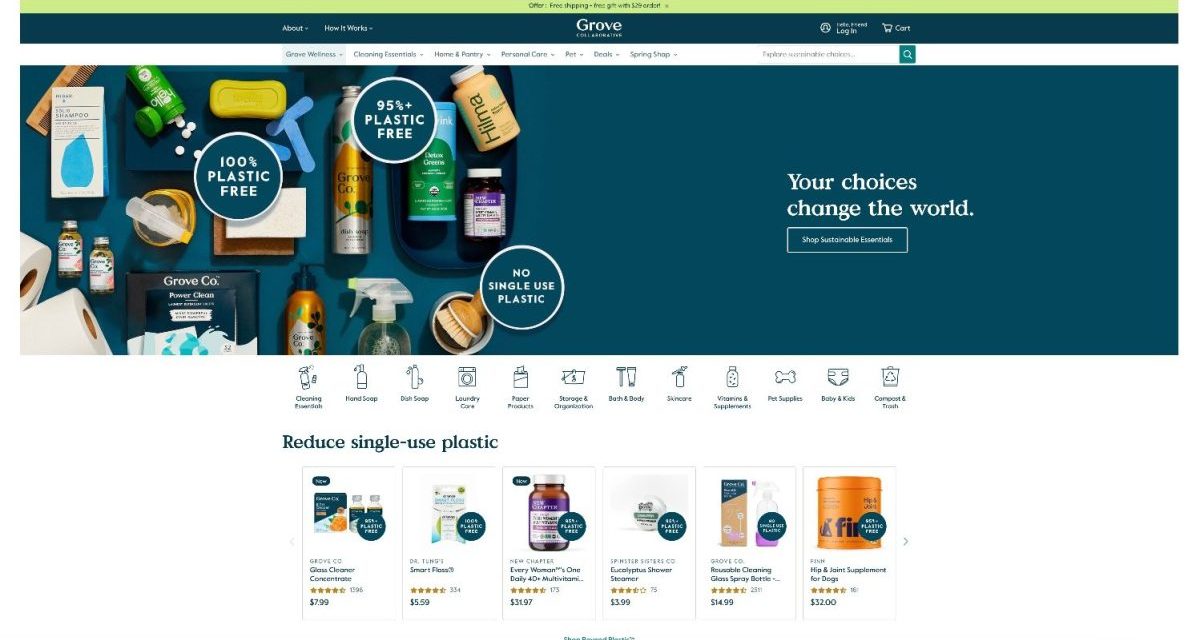To grow its DTC business, Grove no longer requires memberships for purchases

Household products marketplace Grove Collaborative is no longer requiring people to become members or subscribe to place an order, part of a strategy to drive new business after declines in direct-to-consumer orders.
CEO Jeff Yurcisin told Modern Retail that the changes stem from customer feedback that the website was too restrictive. Previously, shoppers had to register with an email address to shop, and their orders were placed on a subscription by default. Moving forward, shoppers can check out as a one-time order. But subscriptions are still going to be offered, with some new flexibility. Shoppers will be able to choose how often shipments arrive and receive an initial 20% discount plus 5% for future orders.
“When you listen to some of the detractors, it’s obvious that we had been inadvertently closing our addressable market with a customer experience that you had to kind of get used to. You had to be comfortable with a default subscription; you have to be comfortable with gated access,” Yurcisin said.
The announcement came the same day as Grove’s fourth-quarter earnings, which reported a year-over-year drop in the number of DTC orders, from 1.37 billion to 864 million. For the full 2023 year, Grove reported $259.3 million in net revenue, a 19.4% decrease over the year due in part to declining DTC sales though still within the company’s guidance range.
Outside of Grove, the changes are yet another example of how DTC brands that have struggled with acquisition are looking to drive business by improving the shopping experience. Sonos revamped its website to emphasize education and information to help it drive DTC sales. Leather goods brand Andar optimized its website to prioritize its product drops without slowing down. Others like Therabody introduce payment technologies like FSA-enabled checkout.
For Grove, which was founded in 2012, the revamped site experience comes after a pivotal two years. Following a $1.5 billion SPAC deal with Richard Branson’s Virgin Group Acquisition Corp II announced in December 2021, the company went public in June 2022. But the initial appetite on the market didn’t last, and shares that soared 68% after the debut have since plummeted to low single digits. Yurcisin took the helm in August 2023, succeeding founder and CEO Stuart Landesberg who remains the company’s executive chairman.
Though Grove’s reputation has been mainly around more sustainable cleaning products, its online marketplace sells more than 200 other brands that span household needs like pet and kid products. Grove’s products are also sold in many retailers’ doors, including Kroger and Target.
The company has sold to more than 5 million customers, many drawn in with incentives like a free cleaning kit with the first subscription. But as many as 4 million have been inactive in the past year — one of the biggest growth opportunities that Yurcisin saw when he came in. Grove started planning the changes in January following multiple rounds of customer listening sessions and surveys conducted in the fourth quarter.
“Those four million customers who haven’t purchased with us in the last year, when we reintroduce ourselves to them, we are quite optimistic that they love our brand. They didn’t necessarily like the way they shop on our site in the past. And so this is an opportunity for us to reintroduce ourselves, reopen the door to earning their trust and bring them back into the fold,” he said.
As part of the checkout changes, Grove also redesigned its homepage to be more product-focused, with more items displayed on the page. And while people won’t have to become members to make an order, they will still be offered freebies once they hit certain spending amounts, like $29. Yurcisin said this strategy helps drive up order value, with the average Grove order being about $67 as of today’s earnings, up from $63 a year prior.
Greg Carlucci, senior director analyst at Gartner, said many online companies are facing scaling challenges, in part because of people looking to shop in-store for more choice and convenience. In response, DTC brands are increasingly revisiting their purposes and assessing what they can offer, including how and when to offer subscriptions.
“The brands that are able to create a clear value proposition and story for subscription are the ones best set up for success,” Carlucci said. “They’ll not only create a model that provides convenience but serves an unmet customer need. Those that are around today are those that have found their niche and purpose.”
Beyond the checkout changes, Grove is also tinkering with how the brand presents itself to shoppers. It’s increasingly focusing on all household products, and not just cleaning supplies. It’s also putting more emphasis on the sustainable nature of products, like more prominent use of its badging system that labels whether something is “95% plastic free” or “100% plastic free.”
To let former customers know about its changes, Grove will experiment with some new marketing strategies in the coming weeks. Yurcisin said that could include putting more investments into Google paid search since subscription-oriented products aren’t typically prioritized in results. He said there could be more of a push into social ads and influencer marketing. Grove, which told investors that it intends to see full-year profitability in 2025, will also continue to deploy new products and make more products eligible for subscription as the new model rolls out.
“I would say a lot of this is merging some of the best practices of a subscription business with the best practices of traditional e-commerce,” Yurcisin said. “We’ve got customers who really still love us, and think of themselves as active customers but didn’t want to shop in that previous way. And so that’s a big part of our growth going forward.”
